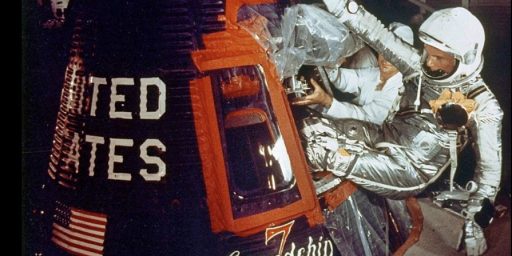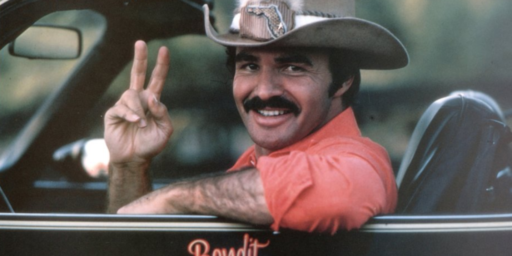Right vs Left: The Labeling Game
Every so often in the blogosphere, the old label argument rears its ugly head. Someone asserts that the old Left vs. Right and Liberal vs. Conservative labels don’t apply and a round of blog posts gets written in reaction.
This time, Glenn Reynolds asserted, for the umpteenth time, that he is not a conservative. Dan Morgan argues that this is a cop-out because there are only two big labels and everybody has to pick one.
If the conservative label does not fit Glenn Reynolds, then why would the lefty bloggers often get so worked up about things that Reynolds writes? Do you think that the people writing or visiting at DailyKos feel any sense of common cause with Reynolds? I think not.
So Glenn, sorry to break the news to you – but you are a Conservative.
This assertion, however, is quite problematic. One, it is not explained why only two labels are permissible and why one must choose between them. Further, it is undermined by Morgan’s own litmus test:
The big tent conservative movement is basically built around the principles that Ronald Reagan put in place. The order of priority, to the great bulk of conservatives, is roughly:
1) Assertive use of U.S. influence, including military force when justifiable, to further U.S. vital interests
2) Reducing the size and power of government
3) Reducing taxes and regulations
4) Expanding many freedoms such as free speech, freedom of association, free markets, and gun freedoms
5) Outlawing abortion, allowing school prayer, and supporting other conservative Christian causes
Glenn is for 1-4 but not 5. So, ipso facto, he’s a conservative, right?
But, objectively, George W. Bush and the Republican Congress are only for 1, 3a, 4d, and 5. Does that make them liberals?
Stephen Green applies some consequentialist logic and asserts, “I can’t agree with Dan on this one, if only because by his lights I’m [a conservative], too.” He then comes up with an interesting set of “five labels to cover beliefs” and “four hyphen-labels to cover the means.” While much more flexible and descriptive than the bipartite Liberal-Conservative schema, it does not solve the fundamental problem that keeps bringing this debate up: disagreement of where others rest on the spectrum. Further, it does not address the problem that people are willing to apply different means to domestic and foreign policy.
More fundamentally, few people are sufficiently consistent intellectually to fit neatly into a categy, anyway. As I noted almost three years ago in response to a Dean Esmay post,
Two axis systems, like Pournelles (linked by Dean) and many others, are typically better than one axis systems, but they tend to create problems. Why? Because most people are inconsistent. They support government regulation of some personal conduct but not others. They support some taxes but not others. Aside from the anarchists, it’s just hard to categorize most people because they don’t think about government all that much and they don’t have very well thought out views.
That is unlikely to change.
Update: Rusty Shackleford, who describes himself as a neo-libertarian but would be a conservative in Morgan’s book, provides an ideological labeling schema complete with a hazy PowerPoint graph, axes, and directional arrows. There is not, however, a paragraph on the back explaining it.
Update 2: And then there are people like Rod Dreher, a religious populist who thinks he’s a conservative because he loves Jesus.
Update 3: Steven Taylor notes that Morgan’s forced choice only exists at election time.
Dave Shuler proposes an alternative tripartite schema of “status quo-ists, revolutionaries, and pragmatists.”
________
Related:






My spectrum contemplates how natural rights are prorated between the individual and society. E.g. it is “conservative” (if you will) to regard freedom of speech entirely retained by the individual. It is “liberal” (as the term is used nowadays) to hold with “political correctness.” A 3D representation of a citizen’s overall outlook (in snapshot) would resemble marbled rye bread as much as anything else.
Ralph is a good example of why this issue is hopelessly muddled.
The core meaning of “conservative” has always been an instinctive fondness for the traditional principles and power structures that have been part of our culture. In the West, these are grounded in the Church, and have always emphasized authority, normative ethics, social control, and the naturalist justification for the rule by elites. It also usually encompassed a paternalistic attitude toward the poor.
Liberalism emerged in reaction, and is/was the grounding for such notions as economic freedom (market capitalism), free thought (science), individual rights, and ultimately, democracy.
On a different axis, “right-wingers” were those who advocated for the interests of the wealthy and powerful, while lefties advance the interests of the poor.
When the church and crown reigned supreme, rightwingers and conservatives were the same. With the growth of economic power through liberal capitalism, you had the emergence of rightwing (wealthy, powerful and self-interested) liberals (those deriving that wealth from capitalist enterprises). The reaction to some of the inhuman aspects of capitalism gave birth to the modern left (often revolutionary) which was and remains antagonistic to much of classical liberalism. Paternalistic socialism of the left has many attitudinal roots in the welfare mentality of classical conservatism (the state, replacing the feudal lord, being responsible for the care of the worker).
In modern America, most of us piece together a worldview that draws on different aspects of this history. Reynolds, to me, seems to be very classicly liberal in some senses (economic), absolutely right-wing (the interests of society are advanced throught the further sucess of the already successful), yet also conservative in that he seems to inclined to support those traditional principles through which social control of the masses was acheived.
Oh, and just by coincidence, there is a story today in the WSJ about “crunchy conservatives” – now that to me is a true conservative in the classical sense – opting out of the full embrace that “modern conservatives” have given to classical liberalism.
http://www.opinionjournal.com/la/?id=110007996
Labels are nice for quickly identifying something, whether a persons political slant or a moving box. But like a labeled moving box, no matter the label, you can still find surprises if you open it up and look inside.
Ideally, we would be able to have a track record with each person we listen to in political discourse so we can understand the lens they are viewing things through. I have a friend who generally votes republican, has core conservative beliefs and actions around his personal life, but doesn’t follow politics much. When an issues catches his attention, I listen up because it gives me an insight in how the non-political right of center might view an issue. If all I did was label him a conservative, I would miss the import of his infrequent political views.
There are several blogs I read often enough to have a good feel for where they will stand on any issue. I am frankly more interested in when they reason a point that is outside of my expectation or when they do a superior job in stating the crux of the issue. Both instances are because they make me think and reason a bit better. I suspect that someone who is more interested in how a blogger is labeled than how they think, is also more likely to read a blog to reinforce their opinion rather than to gain new insight.
Try this test:
http://www.self-gov.org/quiz.html
A 10 question test to see where on the political spectrum your views place you.
As you said earlier, any such test is necessarily crude, because most people (including myself) are inconsistant in their polictical views.